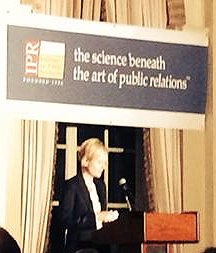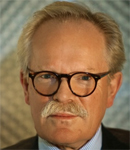The Bill and Melinda Gates Foundation gives away $4 billion a year to battle disease and poverty worldwide “but it’s a drop in the ocean in terms of what needs to be invested to solve these big, complex problems,” Gates Foundation communications head Kate James told the Institute for PR last night at the Yale Club, New York.
 James at the IPR event. |
Since 2000, she noted, the lives of 1.1 million African children have been saved from malaria. She saw the economic as well as the humanitarian impact of disease while working in Saharan Africa for Standard Charter bank.
Up to ten percent of the workforce in Kenya was either ill or looking after somebody who was ill, she noted. “It didn’t just impact our employees, but our suppliers and our customers as well.” An HIV/AIDS epidemic was ravaging the area.
CSR Needs to Align to Bottom Line
“Corporate Social Responsibility efforts,” she said, “need to alight to the bottom line—to facilitate market access, consumer engagement, employee motivation—and it’s only then that you start to see the return on investment. It’s not just about the size of the check, but how companies use their intellectual expertise and human capital.”
James noted that a recent piece in DealBook charged Goldman Sachs with spending too much on CSR. DealBook obtained a quote from Gates Foundation trustee Warren Buffett saying that spending shareholders’ money on CSR is not the right approach.
Therefore, thinking about philanthropy as just the right thing to do has its limitations, James admitted. [Full text of James' remarks]
The top Gates priority now is eliminating polio worldwide. About 99% of the cases have been eliminated so far but the disease is still present in Nigeria, Pakistan and Afghanistan.
James, who is joining Pearson after the first of the year as chief corporate affairs officer, said Pearson has “a massive responsibility—the education of the next generation. And it may be clearer at a place like Pearson where market forces and social changes intersect, but if you look closely—they’re intersecting everywhere. When your companies look to you, they aren’t just asking for your communications insights. They look to you for your understanding of the world in which they operate.”
PR Can Lead—Edlund
 Edlund |
The job of PR people, he said, is to “help leaders think things through. We add context, depth. A chief communications officer’s job is about culture, brand, purpose, reputation, the narrative, and stakeholder engagement. It is about how to shape behaviors, both our behaviors and that of others.”
Edlund said he “probably grew most in the situations when I deeply disagreed with the CEOs but was compelled to understand their priorities, and to faithfully act on them.”
He has worked for 11 CEOs as head of communications. Employers included Shell, Sandoz and ABB. [Full text of Edlund's remarks - PDF]
The thing he missed most about journalism was “the banter.” He said “Reporters and photographers have a light-hearted yet fiercely intense approach to their work. Theirs is a clear-eyed view of the mess that power will leave behind if it moves carelessly through society. The good ones also maintain distance to folk in power.”



 SaaS platforms now allow businesses to effectively manage and execute their own PR campaigns, putting pressure on agencies to demonstrate the value of the “traditional” PR model.
SaaS platforms now allow businesses to effectively manage and execute their own PR campaigns, putting pressure on agencies to demonstrate the value of the “traditional” PR model. Developing a well-designed TV campaign involves asking three important questions.
Developing a well-designed TV campaign involves asking three important questions. How a "Covid silver lining" can show the way to more effective, cost-efficient video communications.
How a "Covid silver lining" can show the way to more effective, cost-efficient video communications.


 Have a comment? Send it to
Have a comment? Send it to 
No comments have been submitted for this story yet.